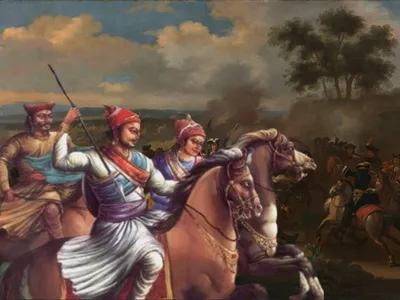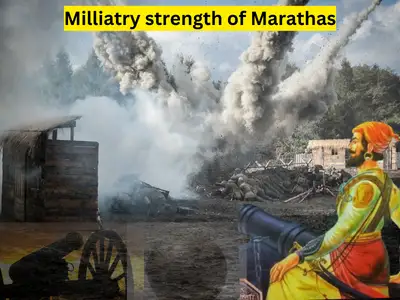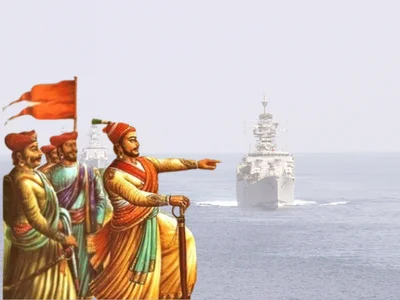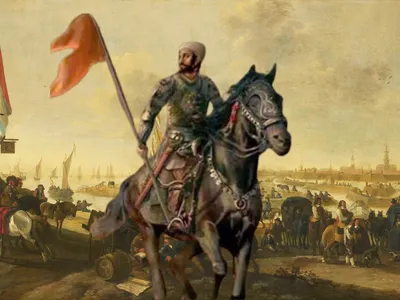Brief Introduction
Chhatrapati Shivaji Maharaj possessed the highest military strength of Marathas and qualities of chivalrous courage , vigilant power and abundant resourcefulness.
He took the fullest advantage of his victories and struck effective blows where they were most unexpected. He had an extraordinary vision to realise the ills of the Muslim army and other opponents and their treacherous move for him and accordingly fight with them by his novel and super impressive military army .
He was the father of the Naval army . He had done a phenomenal job in manufacturing ships and making a strong presence in the ocean of India which was then completely controlled by Portuguese, Dutch and the English.
His administration was of another level which had reached its excellency. He had tried his utmost to undo the evil of feudalism by depriving the old Deshmukh and Deshpande’s of some of their obnoxious rights and prerogatives. He was very much determined not to create new fiefs and renew the evils of military tyranny and feudal anarchy.
Their military strength in land as well as in ocean were well-fortified which had touched the highest peak of success .
Shivaji’s army consisted of the royal Guards, cavalry, infantry , militia, elephant and camel. The forts were the most crucial factor of the strength of the military machine.
The Marathas till the mid 17th century had become the nightmare among the invaders ; Mughal, Sultan of Bijapur, Europeans, Portuguese , etc. The great Chhatrapati Shivaji Maharaj had shown them the days which was proven to be the most darken phase of invaders.
He had realised the super effect of the Gorilla warfare which became one of the major reasons behind the successful Maratha’s victory over Mughal .
He had realised the serious flaw of the feudal levies and therefore he overhauled the whole military machine.
No politician ,statesman or general of that period could stand near to his radius.
Strength of cavalry and infantry
According to Lane Pool, a distinguished historian of the Muslim ruling in India, described the lightening forages and dare-devil manoeuvres of the marathas. He further added
” To fight with Shivaji and his Army was to do battle with air or to strike blows upon water ; like the wind or waves they scattered and bent before the blows only to close in again the moment the pressure was taken off. ”
Lane Pool
After victory over Afzal Khan in 1659 , Shivaji devoted himself to the recruiting and training of his cavalry and infantry. He had produced invincible Army from the poor, ignorant and simple but hard and sturdy Mawalas and other mountaineers.
Enormous wealth seized during depredation had been used to increase his military strength in all arms. The infantry predominated over the cavalry in Marathas army.
The Maratha Army of Shivaji didn’t incumbered with much baggage or equipment. This benefited them in covering 45 to 50 miles in a single March.
Netaji Palkar was sent with 15,000 horses and 12,000 foot (infantry) to make depredations in the Mughal territories in 1661.

Shivaji had 50,000 foot and 10,000 horses in camp during the rainy season of 1664. He started his war with 30,000 soldiers in 1670 against the Mughal.
According to Dutch evidence, Shivaji’s Army strength in 1660 was varied from 50,000 to 60,000. The siledars were raised to 8000 just after Afzal Khan’s death.
According to Sabhasad Bakhar, at the end of Shivaji’s life , his cavalry to be 45,000 regulars and 60,000 irregulars while chitnis chronicles changes the proportion to 80,000 regular and 25,000 irregular siledars . He was said to have 1 lakh of foot soldiers, recruited ,equipped and paid by the states.
Shivaji had enlisted around 700 Pathan in his Army who were deserted from the Bijapur army . At least three of his naval commanders were Muslims by faith.
Maratha weapons
His Army was generally equipped with arms and weapons like swords , Spears, daggers, scimitars, straight rapiyers, poniards, bombs, bows and arrows, match-lock, coat of mail, head-armours, helmets, body armours, armours for horses, grenades, rocket and carbines.
He established factories for manufacturing various kinds of arms and ammunition. He borrowed large weapons from the English, Portuguese ,Dutch and French.
Without tents and equipage, without provisions and other heavy artillery, the light Maratha infantry and cavalry moved with lightning speed from place to place.
These simple plain soldiers of marathas who were trained to bear all the inclemencies of the climate of different parts in their expeditions to Khandesh, berar, etc had performed deeds of heroism, sacrifice and patriotism which won them the admiration of the world.
Shivaji’s great military administration
He had developed a great administrative framework to balance his huge Army . His way of managing the administration was quite different from the Mughals and his other opponents.
There was a Monarchical autocracy in the Marathas military. He had formed a homogeneous body, commanded by a regular cadre of officers who had to obey one supreme commander.
Very strict discipline was followed. No one was spared from punishment for their treachery and indisciplined manner.
The culmination of his ability for orderly administration could be seen when he took 20,000 brahmins with him on his Carnatic expedition to organise and consolidate the newly conquered districts.
The contemporary European writers have borne testimony to the remarkable skill shown by Shivaji in introducing improved methods of administration in the south.
Forts which were won by Shivaji were hardly reconquered by the Mughal or Bijapur.
He kept the military forces under civil administration. He created a graded hierarchy of military officers who were in no way permitted to rule the country. The civil rulers were separate and had nothing to do with the army. But in case of expeditions, ministers were put in charge of the military operations and the army was to obey their orders.
The detective section was considered the backbone of the administration. The Maratha Spies were visible everywhere in the army ,Navy ,Civil department and camps. Even their presence had been seen in other kingdom’s territories. They had expertise in their profession.

They were the one who gave even the minute details of rich merchants of Surat, Hubli, Chhapra and other cities which were plundered by Shivaji . He even knew where the treasures were concealed in the houses.
Even the Mughal Empire had to recognise their Supremacy in the Deccan by granting them chauth and sardeshmukhi of 6 provinces of the south.
Dr. fryer observed that the Maratha camp didn’t enjoy the luxurious life. They had kept themselves away from alcohol, women and dancing girls and other kinds of pleasures .
Martin, the French governor of Pondicherry who had personally visited the Maratha camp , had found the same as Dr. Fryer. According to the writings of Da Guarda, Abbe Carre, Manucci and others, the Mughal army was always lavished with comfort, luxury, presence of women around them (for pleasure) , dancing girls and other comforts.
The Mughal commanders like Shaista Khan, Bahadur Khan and the Mughal Kings had been lost in their comforts.
Reformation
Shivaji abolished the feudal system, watandars, Deshmukhs, Despandes and others continued to enjoy a part of their incomes. A very few attendants in their service who were summoned in emergency. They worked as a reserve.
He considered these levies inefficient, irregular ,indisciplined troops haphazardly raised by a feudal baron for himself.
Structure of Maratha regiments
- Realised the need of the special troops to protect his territories and to become the prime support for him in times of emergency. He started to appoint brave, obedient , faithful and strong soldiers and officers.
- For inspection of the territories and forts, he appointed those whose names were enough to frighten the Army.
- He formed a fourfold force of musketeers, spearmen, light-armed men and artillery men in both the cavalry and infantry.
- Body guards were categorised in 6 different ways. And these were of 100, 60 A, 60 B, 40, 30 and 20 soldiers and known by these numbers.
- Special forces were consisted of 2000 to 2500 men. Government gave them uniforms; consisting of embroidered turbans for heads , jackets of broadcloth for the body, gold and silver rings to be put on their sword-sheaths, two gold bracelets for their hands and a pair of earrings to them. Each of them had Tilak on their forehead.
- There was two types of cavalry
- 1 . Paga belonging to the state.
- 2 . Siledars Or horsemen possessing their own horses as well as arms but accepting service under the state for sometimes.
- In infantry, the smallest unit consisted of 10 men ,commanded by a Naik. Five such units were placed under a Jumledar and two or three Jumlas formed Hazari’s division.
- At that time, there were only seven divisions of Mavle infantry and these were placed under the Sarnobat Yesaji Kank who hold chief command. The cavalry of marathas had comprised of 5 Sarnobats.
- The state cavalry was organised in units of 25 troopers who were under an expert Maratha Hawaldar. Each unit had a water-carrier and a farrier attached to it.
- Five Hawalas made up a Jumla and its officer was a Jumledar. 10 Jumalas consisting of 1250 troopers made up a Hazar. A commander consisted of a Brahmin Mujumdar, Maratha secretary, a prabhu Jamnis and a number of clerks.
- A group of five Hazaris was commanded by a Panch Hazari. All the Panch Hazari generals were directly under the commander-in-chief.
- Each battalion of 1250 horsemen had newswriters, couriers and spies. All these were appointed by the commander in chief. The chief officer of the detective was the famous Bahirji Jadhav.
- Not even a single officers in his Army was hereditary. All officers either high or low, were liable to dismissal, transfer as the case deserved.
- Bargir – A soldier who rode a horse furnished by his employer
- Siledar – A soldier who finds his own horse and arms.
- Pagodas – a unit of currency made by gold or half gold minted.
Payment system of Marathas army
- Every soldier was paid directly by a civil officer and not buy his military commander. He laid down that soldiers and officers should be punctually paid.
- Shivaji’s men and officers were paid either in cash from the central treasury or by Varat Or assignments on the provincial revenue. All were paid decent salaries.
- Jumledar over 125 troopers were given 500 pagodas ( a unit of currency made of gold or half-gold minted) and a palanquin. His accountants were paid 100 – 125 pagodas.
- A Hazari over 1250 troopers received 1000 pagodas, palanquin and other accoutrements of honour. His accountant, secretary and Jamnis received 500 pagodas besides a palanquin was given to each.
- Other types of cavalry consisting of Siledars also received 500 pagodas as mentioned above.
- The Jumledar and the Hazari of the infantry had each a Sabnis who kept the account and the muster roll. They were paid a salary of 40 Hons ( 1 hons varied from 4 to 5 rupees) . While the officer of that name on the Hazari’s staff was given 100- 125 Hons.
Rewards to Maratha Army
- Though Shivaji had rejected the feudalism, he left no stone unturned to confer marks of appreciation to his officers for their thrilling performance.
- To his deserving officers, he gave them the right of carrying aftabgir, an ornamental circular sun shade and of riding in Palki was granted.
- Gold silver and money were given to officers for their conspicious bravery.
- Men who were wounded received an allowance according to the nature of their injuries.
- Widows of soldiers were suitably pensioned.
- He laid down that provision and medicine for men and fodder for their horses should be carefully stored in Cantonments.
- Sabhasad had recorded that heavy rewards were distributed by Shivaji among his Army after destroying Afzal’s Army.
- Kanhoji Nayak who had played a significant role in devastating Afzal Khan’s Army was awarded the first honour of the sword in 1659.
- Shivaji conferred the title of Panch Hazari to two great military officers ; one to Makaji Anand and another to Vyankoji Datto.
- Hansaji Mohite was adorned with title Hamir Rao.
- Officers were given Palki ,horses, elephants and even banners and drums to maintain their status with manificance.
Emergence of Maratha Navy of Shivaji Maharaj
Shivaji Maharaj was the father of the Maratha Navy which had shown terror to the Siddis, Mughal, Portuguese and the English and Dutch. He introduced private merchant marine.
The English, Dutch and Portuguese had the full control on the sovereignty of Indian Ocean. They shared their monopoly on the foreign trade of this country. No Indian ship had the right to stir out in the open sea without taking the permit of these foreign traders.
Shivaji had distinctly found the need of the Maratha Navy if he had to free his Indian ocean from the grip of foreign invaders.
Struggle of Maratha Navy
When Shivaji Maharaj put the foundation of Maratha Navy, they didn’t have much resources to build the ships. The Maratha Navy was composed of a light crew and was no match to a European fleet on the open sea.
He didn’t imitate the Europeans in constructing large men-of-War. As European was then the king of the sea so he didn’t hope to get any European engineers to build his ships or Pilots to manage them nor he could get the necessary guns and ammunition for the big ships.

He began by building indigenous types of vessels which could easily be managed by the Konkan people and could be freely sailed in the creeks and Shallow waters along the rocky coast.
The largest ships were called frigates ( Gurabs) of about 200 – 300 tons whereas European and English had 500-600 tons of ships. Some name of the ships were Gurabs, Gallivats, Shibads, Tarandes, Tarus, pagars, Dubare, Pal, Tirkati, Manchua, Galleons , Hodi, etc.
Structure of Maratha Navy
- According to Ramchandra pant ( member of Ashta Pradhan in Shivaji’s Court ) , the fighting fleet of Shivaji was organised in separate units.
- Each unit consisting of 5 Gurabs, 15 Galivats and some small or light craft. These were organised into two squadrons each under a separate admiral.
- The admiral of the fleet were adorned with title. One of them was titled with Mai- Naik and another officer was styled Dariya Sarang.
- The crew were consisted of Bhandaris, Kolis, Malabaris- Hardy fisherman of the Western coast. These lascars were well- known for their adventures, courage and endurance.
- In 1664, 40 good frigates were lying in the rivers of Kharepatan and Rajapur while 60 new battleships were under construction.
Naval fight with Portuguese and Siddis
As the Portuguese had considered themselves the sole proprietor or owner of the Indian sea, meanwhile Shivaji’s naval presence had become a big threat to them.
Shivaji wrested the power of Portuguese who were the sovereign of the Indian ocean in those days by capturing the maritime ports like Rajapur , Dabhol, etc from Bijapur in 1660.
He reduced Danda Rajpuri along with several other sea-coast towns of the Siddis. He occupied the important port of Colaba near Mumbai and made it his principal Arsenal.
He started to collect Chauth from the Portuguese for Daman and plundered Sunda, Barded and Salsette.
He himself led a Naval expedition with 85 frigates and three great ships for the sack of Port town of Barcelore in 1665.
Shivaji’s naval threat to Aurangzeb
In 1664-65 , Aurangzeb had become so much frightened from the power of Shivaji’s fleet that he instructed the governor of Surat to induce the Dutch with promise of substantial reward to destroy the fleet of Shivaji. But Dutch denied the offer as Shivaji had promised them to give facilities in the Konkan.
The English were also approached by Mughal to not supply arms and ammunition to Shivaji.
Till 1664 Shivaji had possessed around 9 ports which were most Prime in the Deccan. From there, he used to send more than three trading vessels to Persia, Bassora, Mocha, etc. These trading had added a large revenue to the treasure of Shivaji.
Naval Supremacy of Shivaji
He had increased his naval strength to such an extent within 5 years that in 1670 he made a naval demonstration with 160 vessels to strike terror into the hearts of Englishmen, Europeans and Portuguese.
Shivaji built Sindhudurg, Padmadurg, Ratnagiri and Rajkot.
Ramchandra pant through his letter shown his warning to the policies and character of the Europeans.
” The hat-wearers are not just like other merchants. Their Masters behaving like a ruling Kings. Only by getting their orders, these people come to trade in these provinces. How is it possible that rulers have no greed for territories ? They have full greed to enter into these provinces to increase their territories and to established their own religions. Accordingly at various places they had already succeeded in their ambitious undertakings . Moreover, these people are obstinate. Where a place has fallen into their hands, they are not going to give up even at the cost of their lives. So their expansion should be restricted to the extent of only their coming and going for trade. They should never be given any places to settle nor should allow to visit any sea forts. ”
Ramchandra Pant ( member of Astha Pradhan in Shivaji’s court )
References :
- The Military System Of The Marathas ( author – Surendra Nath Sen , Publication date – 1928 )
- Shivaji the Great ( Author – Dr. Bal Krishna , Publication date – 1932 , Publisher: The Arya Book Depot Kolhapur )
- Shivaji and his times ( Author – Jadunath Sarkar , Publication date: 1920 )

4 thoughts on “Shivaji Great Military strength | Cavalry and Infantry War of Marathas”
Comments are closed.